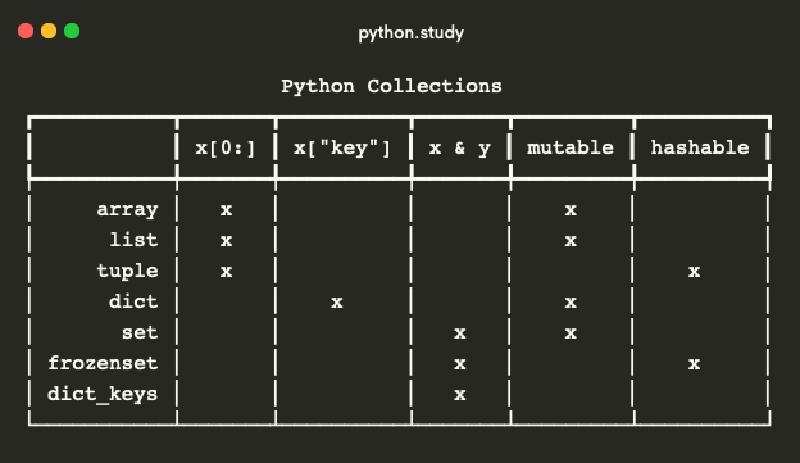Python’s Abstract Base Classes (ABCs) in the collections.abc module are a set of tools that help us check if a class follows a specific interface.
This is done using the issubclass() or isinstance() functions.
The interesting part is that the class we’re checking doesn’t need to inherit from the abstract base type.
It just needs to provide the necessary methods to match the abstract type.
Here’s an example:
from collections.abc import Iterable
class MyClass:
def __iter__(self): ...
def __next__(self): ...
issubclass(MyClass, Iterable)
# Returns True, even though MyClass doesn't inherit from Iterable!
isinstance(MyClass(), Iterable)
# Also True, MyClass doesn't inherit from Iterable,
# but provides the necessary methods.
ABCs are especially useful in a dynamically-typed language like Python, where you often need to inspect an object to determine what it is and what it can do.
Now, let’s use ABCs to explore the properties of standard Python collections. We’ll write a program that builds a table showing which collections support which operations. We’ll use the popular package rich to build the table. This package is great for formatted output in the terminal.
We’ll categorize collections into three types: sequences, mappings, and sets:
- Sequences (like
listsandtuples) support indexing and slicing, so we’ll denote them asx[0:]. - Mappings (like
dict) associate values with keys, so we’ll denote them asx["key"]. - Sets support operations like intersection and difference, so we’ll denote them as
x & y.
We’ll also check whether each collection is mutable and whether it’s hashable (i.e., can be used as a dictionary key).
All this will be determined by a small function written using collections.abc.
Here’s the code:
from collections import abc
def goose_typing(c: abc.Collection) -> list:
# The cells of the table will be marked with 'x' if the test passed
_ = lambda x: 'x' if x is True else ''
mutable = (abc.MutableSequence, abc.MutableMapping, abc.MutableSet)
r = [
c.__name__,
_(issubclass(c, abc.Sequence)),
_(issubclass(c, abc.Mapping)),
_(issubclass(c, abc.Set)),
_(issubclass(c, mutable)),
_(issubclass(c, abc.Hashable)),
]
return r
The function name, goose_typing, is not a mistake.
This approach is indeed called Goose Typing, not Duck Typing.
Now we just need to build the table using the rich package. Here’s the code:
from rich.console import Console
from rich.table import Table
table = Table(title='Python Collections')
table.add_column('', justify='right', style='cyan', no_wrap=True)
table.add_column('x[0:]', justify='center')
table.add_column('x["key"]', justify='center')
table.add_column('x & y', justify='center')
table.add_column('mutable', justify='center')
table.add_column('hashable', justify='center')
from array import array # We'll also investigate the array class
for c in (array, list, tuple, dict, set, frozenset):
table.add_row(*goose_typing(c))
console = Console()
console.print(table)
Running this script will give you a beautiful table showing the properties of standard Python collections.
Python Collections
┏━━━━━━━━━━━┳━━━━━━━┳━━━━━━━━━━┳━━━━━━━┳━━━━━━━━━┳━━━━━━━━━━┓
┃ ┃ x[0:] ┃ x["key"] ┃ x & y ┃ mutable ┃ hashable ┃
┡━━━━━━━━━━━╇━━━━━━━╇━━━━━━━━━━╇━━━━━━━╇━━━━━━━━━╇━━━━━━━━━━┩
│ array │ x │ │ │ x │ │
│ list │ x │ │ │ x │ │
│ tuple │ x │ │ │ │ x │
│ dict │ │ x │ │ x │ │
│ set │ │ │ x │ x │ │
│ frozenset │ │ │ x │ │ x │
└───────────┴───────┴──────────┴───────┴─────────┴──────────┘
Using Goose Typing, you can check whether an unknown object you’ve received matches a certain interface, and then decide how to work with it.
Let’s try to investigate something more interesting than list or dict. For example, this:
# ... right after the loop
d = dict()
table.add_row(*goose_typing(d.keys().__class__)) # dict_keys
The result:
Python Collections
┏━━━━━━━━━━━┳━━━━━━━┳━━━━━━━━━━┳━━━━━━━┳━━━━━━━━━┳━━━━━━━━━━┓
┃ ┃ x[0:] ┃ x["key"] ┃ x & y ┃ mutable ┃ hashable ┃
┡━━━━━━━━━━━╇━━━━━━━╇━━━━━━━━━━╇━━━━━━━╇━━━━━━━━━╇━━━━━━━━━━┩
│ array │ x │ │ │ x │ │
│ list │ x │ │ │ x │ │
│ tuple │ x │ │ │ │ x │
│ dict │ │ x │ │ x │ │
│ set │ │ │ x │ x │ │
│ frozenset │ │ │ x │ │ x │
│ dict_keys │ │ │ x │ │ │
└───────────┴───────┴──────────┴───────┴─────────┴──────────┘
The result is interesting. The dict_keys object, returned by calling keys() on a dictionary, behaves like a set, but is neither mutable nor hashable.
This means you can find common keys between two dictionaries like this:
d1 = {'1': 1, '2': 2}
d2 = {'1': 1, '3': 3}
print(d1.keys() & d2.keys()) # sets intersection
# Outputs the common keys between two dictionaries: {'1'}
ABCs and Goose Typing can help you to write more type-safe code in Python.
You can read about Goose Typing in the wonderful book Fluent Python, by Luciano Ramalho. For more information on ABCs, check out the official Python documentation.
For more on the rich package, see the docs.
